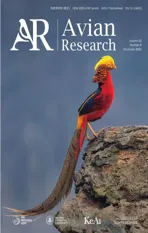GPS tracking data reveal the annual spatiotemporal movement patterns of Bridled Terns
2023-01-03XinYuPingFanYunWuYongbinChangChenxiJiaFuminLei
Xin Yu,Ping Fan,Yun Wu,Yongbin Chang,Chenxi Jia,Fumin Lei,c,**
a Key Laboratory of Zoological Systematics and Evolution,Institute of Zoology,Chinese Academy of Sciences,Beijing,100101,China
b College of Life Sciences,University of Chinese Academy of Sciences,Beijing,100049,China
c Center for Excellence in Animal Evolution and Genetics,Chinese Academy of Sciences,Kunming,650201,China
Keywords:GPS-GSM Transmitters Bridled tern Fidelity Migration
ABSTRACT Understanding the spatiotemporal patterns of animal movement is a central theme in the growing field of movement ecology.The Bridled Tern(Onychoprion anaethetus)is widely distributed across tropical and subtropical latitudes;however,knowledge of its annual movement is based only on relatively scarce recoveries of ringed birds.Studying the annual movement of pelagic seabirds is important to identify the impact of changes of marine habitats on them.We examined fine-scaled movement patterns of the species from two colonies in southern China by using GPS-GSM transmitters in 2018–2022.Twenty-three terns bred in Xichiyu Islet and Qilianyu Islet while wintered in four different sites:Gulf of Thailand,Natuna Islands,The Sulu Sea,and Makassar Strait.Bridled Terns made small detours and employed a fly-and-forage strategy with frequent stopovers to forage during autumn migration,but took more direct routes and reduced the need for stopovers during spring migration.Distance of migration between breeding and winter sites was significantly longer in autumn(average 3635 km)when compared with spring(2777 km).Ten birds with whole-year tracking data used the same breeding sites both years and four birds with tracking data of two consecutive years returned to the same wintering area,indicating that Bridled Terns are highly faithful to their breeding and wintering grounds.
1.Introduction
Studies on migration of small sized seabirds are currently growing rapidly due to the development of miniature locators in recent decades.For example,light-level geolocators have been applied in studies of terns(Arctic Tern Sterna paradisaea,Common Tern S.hirundo)to identify wintering areas and stopovers in long-distance migration(Egevang et al.,2010;Becker et al.,2016;Kralj et al.,2020).However,light-level geolocators that provide less precise location data are not suitable for fine-scale studies,such as examining the migration routes and strategies in distances of hundreds to thousands of kilometers(Surman et al.,2018;Thiebot et al.,2020).Light weight tracking equipment(≤5 g)has recently been developed and the satellite and tracking technology has been successfully used to study detailed annual migration patterns and foraging behaviours during breeding seasons of small sized terns,such as the Gull-billed Tern(Gelochelidon nilotica)(Goodenough and Patton,2019)and the Arctic Tern(S.paradisaea)(Morten et al.,2022).
The Bridled Tern is strictly a marine species with a large,nearly worldwide distribution range across tropical and subtropical latitudes(Gochfeld and Burger,1996).Variation in the population sizes and the breeding biology of Bridled Terns on different temporal-spatial scales have been revealed by the recoveries of ringed birds and observation(Howell and Webb,1995;Villard and Bretagnolle,2010;Perera and Ilangakoon,2016),but their annual movement pattern is still largely unknown,particularly during the nonbreeding season.Here,we present the first GPS-tracking data on spatial and temporal movement along the whole migratory route.Our study aims to 1)elucidate the annual migration patterns,including the main routes,stopovers and wintering areas;2)compare the similarities and differences in spring and autumn migration scenarios,including migration duration,speed,distance and route;3)identify breeding and wintering sites fidelity in the Bridled Terns.
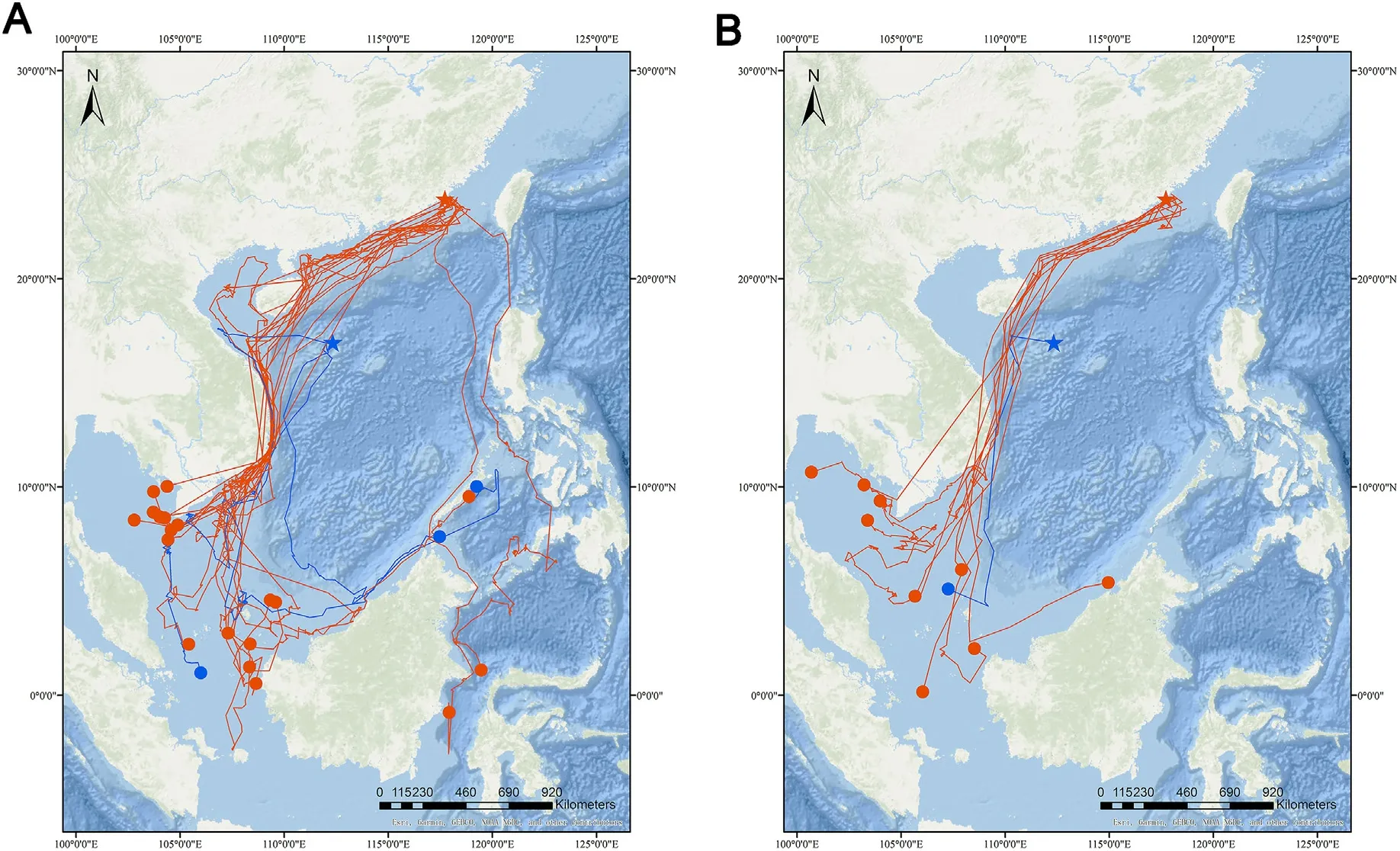
Fig.1.General overview of movements of Bridled Terns as tracked by GPS-GSM transmitters in autumn(A)and spring(B).The locations of the breeding colonies are indicated by stars,and wintering sites are indicated by circles(different colours indicate different breeding colonies).(For interpretation of the references to colour in this figure legend,the reader is referred to the Web version of this article.)
2.Methods
2.1.Field work and tracking devices
Twenty-eight adult Bridled Terns from two breeding colonies in southern China(Xichiyu Islet in Fujian Province,23.8244°N,117.7315°E,and Qilianyu Islet in Hainan Province,16.9298°N,112.3459°E)were equipped with solar powered 4.5 g Global Positioning System(GPS)-Global System for Mobile communications(GSM)transmitters(twenty devices of Hunan Global Messenger Technology Co.,Ltd.and eight devices of Hangzhou Yuehai Technology Co.,Ltd.)using legloop harnesses made of Teflon(Mallory and Gilbert,2008)from July to September in 2018(four birds),2019(six birds),2020(nine birds)and 2021(nine birds).We trapped the Bridled Terns at the colonies using mist nets and processed them in situ.All birds were marked with individually numbered plastic leg bands,and morphometric measurements were made to assess the size and weight prior to marking.Transmitters and harness attachments were typically less than 4%of the body weight of the tern.Both transmitter types were powered by rechargeable batteries and a solar-powered panel for satellite positioning via GPS.Positioning data were transmitted by GSM.The maximal and minimal temporal resolutions achieved by the loggers were 6 h and 24 h,respectively,depending on the power level of the battery and whether birds traveled to areas outside the range of the cellular GSM network.The accuracy of locations was between 5 m and 100 m.
2.2.Identifying movement and areas utilization
Twenty-four birds were tracked for more than half a year,which encompassed a complete autumn migration(see Appendix Table S1 for detail).The onset of autumn migration was defined as the last day the bird was present at the breeding colony.The end of the autumn migration was defined as the first day the bird arrived at its first wintering site(some terns used multiple sites during the winter,see Results).The onset and end of spring migration were determined in a similar manner.A stopover day was defined as when the bird used the same night roost as the previous night(Klaassen et al.,2012;Becker et al.,2016).The total migration distance was calculated as the sum of the distances on travelling days(excluding movements during the stopovers).The migration routes of the terns were mapped by ArcGIS 10.7.
2.3.Statistical analysis
Data were analyzed using the statistical software R 4.1.1(R Core Team,2021).ANOVA test was conducted to identify the differences in migration distances and duration between spring and autumn and between the two breeding grounds.Pearson correlations were performed to determine associations among the following variables:stopovers and migration distance,the onset of autumn or spring migration and arrival at the destination.All tests were considered significant at a level of P<0.05.The distributions of the migration duration and distance in spring and autumn were plotted as bean-plots using the R package‘beanplot’(Kampstra,2008).
3.Results
The transmitters of four birds(F020,F115,Y06 and S6)stopped transmitting approximately one month after the birds left their breeding sites.One bird(Y19)could not be determined to return to same breeding sites used previous year due to invalid GPS data during breeding seasons in 2021 and 2022(Appendix Fig.S1).Some individuals were not analyzed for differences in spring and autumn distance,due to invalid GPS data en route(Fig.2).Twenty-four Bridled Terns with GPS-GSM transmitters exhibited two autumn migration routes,either following the coastline or the island chain,and show four different wintering sites,including the Gulf of Thailand,Natuna Islands,Sulu Sea and Makassar Strait.Twenty-two birds from the Xichiyu Islet breeding site wintered at the above four sites,and the other two birds from Qilianyu Islet wintered around the Natuna Islands and the Sulu Sea(Fig.1).There was no significant difference in autumn migration distance between the two colonies(F=2.65,P=0.12).Moreover,the Bridled Terns displayed seasonally distinct migration behaviors.Birds made small detours in the autumn,while more straight and direct routes in spring migration.Hence,total distance traveled was significantly longer during the autumn than spring migration(F=4.86,P=0.04).There were more stopovers in autumn than spring migration,but the differences are not statistically significant(F=1.10,P=0.30).The birds had average 1.75 stopovers and the average duration of a single stopover was 6.39 days(range 2–18 days)in autumn migration.No significant correlation was found between stopovers and autumn migration distance(R=-0.46,P=0.11).However,only one bird made two stopovers in spring migration(Fig.2).On average,Bridled Terns spent 26±12 days and traveled 3635±545 km on their autumn migration,while they spent 18±11 days and traveled 2777±918 km on their spring migration(Fig.3).
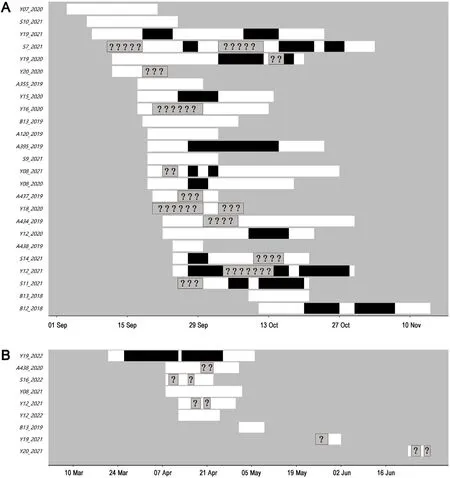
Fig.2.Travel days(in black)and stopover days(in white)during autumn(A)and spring migration(B)of Bridled Terns.Birds were ranked after departure date.
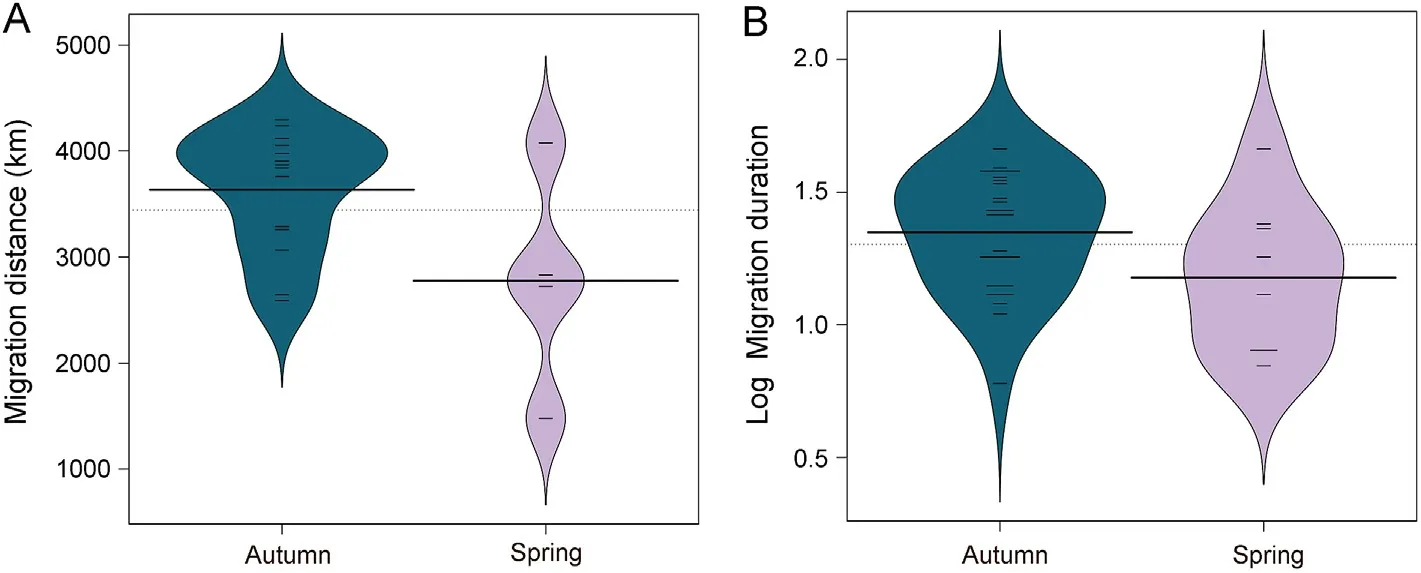
Fig.3.Four representative migratory travels of Bridled Terns illustrating annual movements of four wintering populations.Dotted lines represent the trajectory of the stage in the second year.Lower panels depict latitude over time.We distinguished between breeding season(green),autumn migration(red),wintering area(blue),and spring migration(yellow).(For interpretation of the references to colour in this figure legend,the reader is referred to the Web version of this article.)
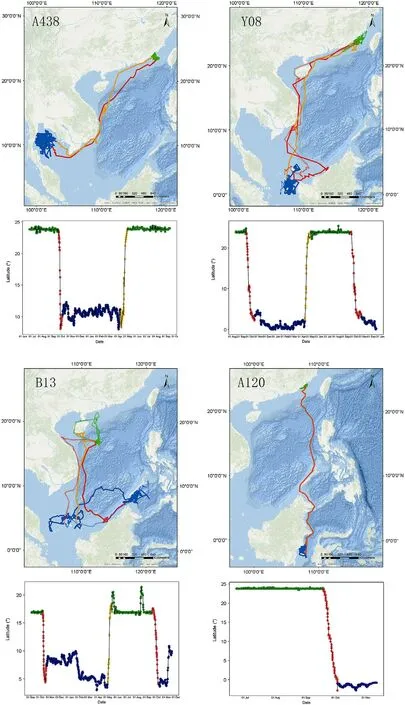
Fig.4.Seasonal differences in migration distance(A)and duration(B)of Bridled Terns.The small lines represent individual data points,longer solid lines represent a per-batch average and dotted lines represent an overall average,while the color area shows the distribution.(For interpretation of the references to colour in this figure legend,the reader is referred to the Web version of this article.)
We recorded a total of 32 departures from the breeding sites.The first bird departed from the breeding sites on 3 September and the last on 11 October,with 81% of the birds departing in mid-late September.They arrived at wintering grounds between 21 September and 3 November(Fig.2).There was a significant correlation between the date of departure from the breeding sites and arrival at wintering grounds(R=0.51,P=0.01).Departures dates of individuals bred in Qilianyu Islet at low latitudes was significantly delayed compared to that of individuals bred in Xichiyu Islet at relative high latitudes(F=9.25,P=0.004).The birds started spring migration between 21 Mar and 23 June and completed it between 23 April and 30 June.A significant correlation was found between the onset of spring migration and arrival at the breeding ground(R=0.92,P=0.0003).Ten terns(A438,B13,S14,S16,S19,Y08,Y12,Y15,Y18 and Y20)that were tracked longer than 12 months returned to the same breeding sites that were used the previous year and one of them(Y12)returned to the same breeding site for consecutive two years.Four terns(B13,Y08,Y12 and Y19)that were tracked longer than 15 months returned to the same wintering sites that were used the previous year.This suggests that there was strong fidelity to both breeding and wintering sites.Besides,many birds wandered over the sea during winter(such as B13,B12,Y15),which led to a large range of wintering areas and multiple wintering sites(Fig.4).
4.Discussion
4.1.General routes
By using GPS-GSM transmitters,our study found that the Bridled Terns depicted different migratory behaviors during autumn and spring seasons.Bridled Terns made small detours and employed a fly-and-forage strategy with frequent stopovers to forage during autumn migration,but took more direct routes and reduced the need for stopovers during spring migration.The fly-and-forage strategy was considered as a behavior that combines foraging with covering migratory distance,as the travel costs may be reduced by incorporating energy intake with flight(Strandberg and Alerstam,2007).The strategy has been observed in other terns,such as Caspian Terns(Hydroprogne caspia)(Rueda-Uribe et al.,2022)and Arctic Tern(S.paradisaea)(Redfern and Bevan,2022).The majority of Bridled Terns made small detours to follow coastlines on their southward migration.Coastlines seem to be important routes preferred by seabirds,such as Lesser Black-backed Gulls(Larus fuscus)(Klaassen et al.,2012),Arctic Tern(S.paradisaea)(Egevang et al.,2010)and Commen Tern(S.hirundo)(Piro and Schmitz Orn′es,2022).This is probable because coastal habitats contain predictable sources of food and create opportunities for energetically efficient soaring(Hedenstr¨om,1993;Shamoun-Baranes et al.,2016),from which the birds may benefit from.In this study,the distance of spring migration was significantly shorter than that in autumn,mainly because the Bridled Terns employed relatively direct routes with a few stopovers on their northward migration.When accumulated fat is sufficient,birds can follow a straight and direct migration route,such as Common Shelducks(Tadorna tadorna)(Wang et al.,2018).Another possible reason for following direct routes could be that birds would shorten migration distance to arrive at the breeding ground earlier,and there were shorter duration and stopover sites in spring when compared with autumn,although the differences are not statistically significant.
4.2.Distributed wintering regions
The individuals wintered in four areas,although twenty-two birds were tagged at the same breeding colony.The two farthest wintering grounds were 2148.74 km apart.The east and west of the four wintering centers were 18 degrees of longitudes apart.We inferred that wintering areas,especially near the equator,should be chosen by breeding individuals from the northern and southern hemispheres in different periods.For example,our results showed that two Bridled Terns bred at Xichiyu Islet(south of China)arrived at the Makassar Strait in October and November.Surman et al.(2018)pointed out that two Bridled Terns tracked from the Houtman Abrolhos(western Australia)migrated to the Java Trench region of the Indian Ocean,along the west coast of Sulawesi and the Makassar Strait during May–September(Surman et al.,2018).Moreover,the Sulu Sea is an important wintering area for Bridled Terns from Western Australia(Dunlop and Rippey,2006),and for those from southern China included in our study(Fig.1).Therefore,same suitable areas can be chosen by individuals from the northern and southern hemispheres in different periods.Long-term monitoring of individual movements suggests strong fidelity to breeding and wintering grounds,with ten individuals returning to previously used breeding grounds and four individuals returning to previously used wintering grounds.Site fidelity seems to be a common feature in several tern species,which has also been reported in the Lesser Crested Tern(Thalasseus bengalensis)(Hamza et al.,2017),the Gull-billed Tern(G.nilotica)(Goodenough and Patton,2019),the Least Tern(S.antillarum)(Atwood and Massey,1988),the Sooty Tern(O.fuscatus)(Jaeger et al.,2017)and the Australian Fairy Tern(Sternula nereis nereis)(Dunlop and Greenwell,2020).The birds visited same sites between successive years,which may be the result of philopatry to particular breeding and wintering grounds and cognition for suitable habitats with predictable resources(Reed and Oring,1993;Wakefield et al.,2015).Site fidelity also provides a fitness advantage to the birds by reducing the costs of prospecting for a new breeding site(Naves et al.,2006)and unpredictable habitats(Switzer,1993;Hoover,2003).In addition,within-winter movements of birds possibly occur as a response to the gradual depletion of food resources and variability in climate(Lovvorn,1989;Keller et al.,2009).
5.Conclusion
We used data from high-resolution GPS-GSM transmitters across multiple years to identify the annual spatiotemporal movement patterns of the Bridled Tern,important nonbreeding areas in southeast Asia,seasonally distinct migration behaviors and strong fidelity to breeding and wintering sites.Miniature tracking devices providing more detailed information on movement trajectories offer the opportunity to study how populations vary over multiple spatio-temporal scales and to better understand the relationship and interaction between terns and marine environment.
Ethics statement
The field work was performed by experienced researchers according to the guidelines of the Animal Ethics Committee of Institute of Zoology,Chinese Academy of Sciences,and approved by the local forestry department.
Authors’contribution
CJ and FL administrated and designed the study.XY,YW,YC and CJ curated data and performed the field work.XY wrote the manuscript,PF,CJ and FL edited and revised the manuscript.All authors read and approved the final manuscript.
Declaration of competing interest
The authors declare that they have no competing interests.
Acknowledgements
We thank Zuohua Yin,Xiaolu Jiao and Hongrui Lv for their assistance in the field.We thank Kasper Thorup,three anonymous reviewers and Yanzhu Ji for suggestions on an earlier version of the manuscript.This study was supported by grants of the National Natural Science Foundation of China(No.31727901)and the National Key Research and Development Program of China(2022YFC2601600).
Appendix A.Supplementary data
Supplementary data to this article can be found online at https://do i.org/10.1016/j.avrs.2022.100065.
杂志排行
Avian Research的其它文章
- Comparative population genomics reveals glacial cycles to drive diversifications in tropical montane birds(Aves,Timaliidae)
- Identification of annual routines and critical stopover sites of a breeding shorebird in the Yellow Sea,China
- Differing migration patterns and year-round habitat-use of allopatric nesting Eastern Tundra Bean Geese(Anser fabalis serrirostris)in East Asia
- Ecological traits affect the seasonal migration patterns of breeding birds along a subtropical altitudinal gradient
- Demographic and behavioral responses of the White-winged Dove to human disturbances during winter in northwestern Mexico
- Urban avifauna distribution explained by road noise in an Eastern European city
